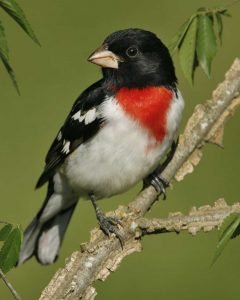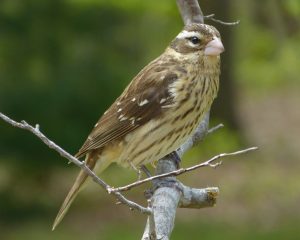Every year, year after year, for thousands of years, our Appalachian mountains have been witness to one of nature’s most fantastic sights: the bird migration. Not only is this so incredible that it borders on fantasy, but it also is incredible in that it happens not once, but twice every year. Our home is the way-station and the destination for dozens of species of these remarkable creatures that we so take for granted.
 Most of the time when folks talk about bird migration we think of waterfowl, the ducks, geese and swans that move each spring from their winter homes far to the south, up the flyways to the breeding and nesting areas of the Canadian prairie provinces, and that travel south again in late summer and early fall. There are four North American flyways, the Pacific, Central, Mississippi and Atlantic, and our Appalachian home is near the border of the Atlantic and Mississippi flyways, allowing us to encounter birds from both, those individuals that come along our rivers, from them. During my years with the Virginia Game Department in Southwest Virginia, we trapped and banded hundreds of waterfowl in various research projects and I have to confess, of all the work those years held for me, it was working with waterfowl that brought me the most joy. We used both swim-up and walk-in traps and that marvel of wildlife research, the rocket net. We had band recoveries from our work from as far away as Texas and Canada and I cannot think of those birds without wondering what they saw on their travels. There are many stories in traditional sporting literature of the imaginations of farm and city kids alike being stirred by the midnight honking of a skein of geese, passing over on their journey. Perhaps this is why even today, on my keychain I carry a returned leg band from my wood duck trapping days.
Most of the time when folks talk about bird migration we think of waterfowl, the ducks, geese and swans that move each spring from their winter homes far to the south, up the flyways to the breeding and nesting areas of the Canadian prairie provinces, and that travel south again in late summer and early fall. There are four North American flyways, the Pacific, Central, Mississippi and Atlantic, and our Appalachian home is near the border of the Atlantic and Mississippi flyways, allowing us to encounter birds from both, those individuals that come along our rivers, from them. During my years with the Virginia Game Department in Southwest Virginia, we trapped and banded hundreds of waterfowl in various research projects and I have to confess, of all the work those years held for me, it was working with waterfowl that brought me the most joy. We used both swim-up and walk-in traps and that marvel of wildlife research, the rocket net. We had band recoveries from our work from as far away as Texas and Canada and I cannot think of those birds without wondering what they saw on their travels. There are many stories in traditional sporting literature of the imaginations of farm and city kids alike being stirred by the midnight honking of a skein of geese, passing over on their journey. Perhaps this is why even today, on my keychain I carry a returned leg band from my wood duck trapping days.
For all the attention ducks and geese get, for me the songbird migration is by far the most fascinating. Many species of Neotropical migrant songbirds, those that winter in tropical regions and migrate north for breeding and nesting, make the Appalachian Mountains their destination. These species may fly from the far southern depths of South America to reach our forests and back yards, thousands of miles over jungle and ocean alike. If you need a reason to justify the science of forestry (besides toilet paper and the wood house you live in) try this on for size: over 80% of these Neotropical species nest within 3 feet of the ground—if there is no timber cutting, then there is no young forest; there will be no nesting. Just putting it out there for your consideration…
In just a few weeks the spring migration will begin; because I am a spring turkey hunting addict I will see this phenomenon first-hand, from the first of April until the last of May. Herein, allow me to bring you the Grosbeak Lesson.
When the turkeys aren’t gobbling in the mornings, being a basically lazy person and not wanting to go home and back to work, I usually divert my attention to other things in the turkey woods. This is on the faint hope I might hear a bird, of course, but mostly because I am not ready to leave the woods. This is mostly normal behavior for spring turkey hunting addicts.
For the 2016 season the weather had been generally terrible. I have not done the math but the average temperature at daylight for the entire season was below 50 degrees. The turkey I killed the third week was killed on the only really good temperature morning, and it was only 57 degrees then, but I did hear Whip-poor-wills that morning before it got light. That is the only morning I have heard them since May of 2015.
This I was thinking about this particular morning, when the sun was just hitting the ground where I sat near the edge of the woods on Buck Mountain. A burst of color shocked me as it flew by and suddenly I was looking at a mated pair of rose-breasted grosbeaks, the drab female with a sliver of bark in her beak, and three feet away perched on another limb the male, all gussied up in his black-and-white tuxedo with the bright red splotch on his chest like spilled wine. Then I noticed that I was smiling.
 The pair were making repeated trips from their chosen nest tree, a good-sized black cherry on the edge of the woods, to a lightning-blasted maple where the female was making her selections from the bark strips and fibers on the dead trunk. On every trip, without fail, as she was all business flying first to one, then the other, then back again, the male was never more than three feet from her; when she would alight to pull bark he was perched on a peg of a limb above her, and when she came back to the nest tree and while she worked the piece into her nest, he was perched above her on a thin limb, watching with due scrutiny. At each stop he serenaded her with a beautiful short song; not being able to speak grosbeak I can only assume he was extolling his virtues as a parent-to-be, and of course noting her staggering loveliness (for what is drab to us humans can be gorgeous to grosbeaks I suppose). I remember reading in college that the male grosbeak is a true partner in the association—he actively defends his nest territory from others of his kind with his song and by physical force if necessary, and he actively helps care for the fledglings, bringing food back to the nest and watching over the young while the female builds another nest. This type of pair bonding is usually only associated with birds like Canada geese and some eagles, and may possibly indicate a longer association than the usual once-a-year meet and greet of most songbirds.
The pair were making repeated trips from their chosen nest tree, a good-sized black cherry on the edge of the woods, to a lightning-blasted maple where the female was making her selections from the bark strips and fibers on the dead trunk. On every trip, without fail, as she was all business flying first to one, then the other, then back again, the male was never more than three feet from her; when she would alight to pull bark he was perched on a peg of a limb above her, and when she came back to the nest tree and while she worked the piece into her nest, he was perched above her on a thin limb, watching with due scrutiny. At each stop he serenaded her with a beautiful short song; not being able to speak grosbeak I can only assume he was extolling his virtues as a parent-to-be, and of course noting her staggering loveliness (for what is drab to us humans can be gorgeous to grosbeaks I suppose). I remember reading in college that the male grosbeak is a true partner in the association—he actively defends his nest territory from others of his kind with his song and by physical force if necessary, and he actively helps care for the fledglings, bringing food back to the nest and watching over the young while the female builds another nest. This type of pair bonding is usually only associated with birds like Canada geese and some eagles, and may possibly indicate a longer association than the usual once-a-year meet and greet of most songbirds.
These birds wintered somewhere in Central America or Northwestern South America. Now, I’m not saying that it was fate or a miracle that they were there with me (or, actually, I was there in their spot at that exact moment in time to observe their ritual), or that by some miracle of nature they flew 2,000 miles and happened to pick the very tree I was sitting near for their home, but it occurred to me at that moment, after watching these two for over an hour, how very much like our Appalachian forbearers these little birds are. God gave them a big, beautiful world for their lives and the only obligation he placed on them was that they must show up. That’s all. I don’t know but I assume that grosbeaks don’t worry about a rain wash-out of the nest before it’s finished, or a bad wind, or that Cooper’s hawk I can hear down in the hollow; it seems to me that all they concern themselves with is showing up and doing the job, focused on each other and the task at hand. There is no yesterday or tomorrow for grosbeaks, only this moment, and there is a beautiful simplicity in that, in answering God in the only way possible for them, and it simply staggered me when I saw it. They showed up. And they will show up, every time, regardless of weather or wind or the vagrancies of Cooper’s hawks.
And that is the grosbeak lesson. And yes, I’m still smiling over it.
Class dismissed.


